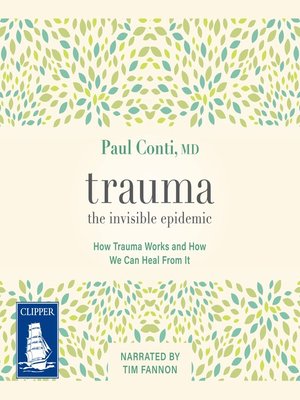Trauma
audiobook (Unabridged) ∣ The Invisible Epidemic: How Trauma Works and How We Can Heal from It
By Paul Conti

Sign up to save your library
With an OverDrive account, you can save your favorite libraries for at-a-glance information about availability. Find out more about OverDrive accounts.
Find this title in Libby, the library reading app by OverDrive.



Search for a digital library with this title
Title found at these libraries:
| Loading... |
A Journey Toward Understanding, Active Treatment, and Societal Prevention of Trauma Imagine, if you will, a disease—one that has only subtle outward symptoms but can hijack your entire body without notice, one that transfers easily between parent and child, one that can last a lifetime if untreated. According to Dr. Paul Conti, this is exactly how society should conceptualize trauma: as an out-of-control epidemic with a potentially fatal prognosis.
In Trauma: The Invisible Epidemic, Dr. Conti examines the most recent research, clinical best practices, and dozens of real-life stories to present a deeper and more urgent view of trauma. Not only does Dr. Conti explain how trauma affects the body and mind, he also demonstrates that trauma is transmissible among close family and friends, as well as across generations and within vast demographic groups.
With all this in mind, Trauma: The Invisible Epidemic proposes a course of treatment for the seemingly untreatable. Here, Dr. Conti traces a step-by-step series of concrete changes that we can make both as individuals and as a society to alleviate trauma's effects and prevent further traumatization in the future. You will discover:
- The different post-trauma syndromes, how they are classified, and their common symptoms
- An examination of how for-profit health care systems can inhibit diagnosis and treatment of trauma
- How social crises and political turmoil encourage the spread of group trauma
- Methods for confronting and managing your fears as they arise in the moment
- How trauma disrupts mental processes such as memory, emotional regulation, and logical decision-making
- The argument for a renewed humanist social commitment to mental health and wellness
It's only when we understand how a disease spreads and is sustained that we are able to create its ultimate cure. With Trauma: The Invisible Epidemic, Dr. Conti reveals that what we once considered a lifelong, unbeatable mental illness is both treatable and preventable. "Trauma: The Invisible Epidemic will be a game changer. It provides not only the wisdom and intelligence of the author—an experienced professional in the worlds of psychiatry and sociology—but unlike other intellectual books written about trauma, Paul's offers a multitude of solutions. These practical responses to trauma address everything from physical and mental health to encouraging self-care and correcting unhealthy behaviors. Trauma affects countless individuals and families, and Paul's book is carefully thought out and explained in ways that are understandable to everyone. Wisdom and patience prevail in his unique outlook on a subject that has been largely ignored by doctors for years." Tommy Hilfiger, entrepreneur, author, and philanthropist "Dr. Conti explains how trauma interacts with the way our brains work and how trauma is affected by certain aspects of society, and he does so with vivid illustrations of real people and their lives. But this book doesn't just stop there. Dr. Conti also provides real solutions people can use for themselves and their loved ones, and solutions to help make the world a kinder and safer place." Kim Kardashian, actress, producer, and businesswoman "Paul Conti is one of the most unique and thoughtful physicians I have ever met. His approach to psychiatry is interactive both with the patient and with the referring physician. I have a large, successful concierge practice in New York and am often asked to see patients with comp






